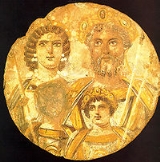
Severan Tondo
Encyclopedia
The Severan Tondo, from circa AD 200, is one of the few preserved examples of panel painting
from Classical Antiquity
. It is a tempera
or egg-based painting on a circular wooden panel (tondo
), with a diameter of 30.5 cm. At present, it is on display at the Antikensammlung Berlin
(inventory number 31329).
The panel depicts the Roman Emperor
Septimus Severus with his family: to the left his wife Julia Domna
, in front of them their sons Geta
and Caracalla
. All are wearing sumptuous ceremonial garments; Septimus Severus and his sons are also holding sceptre
s and wearing gold wreaths decorated with precious stones. Geta's face has been removed, probably after his murder by his brother Caracalla and the ensuing damnatio memoriae
.
The image is probably an example of imperial portraits that were mass-produced to be displayed in offices and public buildings throughout the empire - as part of Roman legal procedure some documents had normally to be signed in front of an image of the Emperor, which gave them the same status as if signed in his actual presence. With each change of emperor, they would have been discarded or replaced. Since wood is an organic material and does not normally survive, the Berlin Tondo remains, so far, the only surviving specimen of this type of painting. It appears to be of Egyptian origin.
Panel painting
A panel painting is a painting made on a flat panel made of wood, either a single piece, or a number of pieces joined together. Until canvas became the more popular support medium in the 16th century, it was the normal form of support for a painting not on a wall or vellum, which was used for...
from Classical Antiquity
Classical antiquity
Classical antiquity is a broad term for a long period of cultural history centered on the Mediterranean Sea, comprising the interlocking civilizations of ancient Greece and ancient Rome, collectively known as the Greco-Roman world...
. It is a tempera
Tempera
Tempera, also known as egg tempera, is a permanent fast-drying painting medium consisting of colored pigment mixed with a water-soluble binder medium . Tempera also refers to the paintings done in this medium. Tempera paintings are very long lasting, and examples from the 1st centuries AD still exist...
or egg-based painting on a circular wooden panel (tondo
Tondo (art)
A tondo is a Renaissance term for a circular work of art, either a painting or a sculpture. The word derives from the Italian rotondo, "round." The term is usually not used in English for small round paintings, but only those over about 60 cm in diameter, thus excluding many round portrait...
), with a diameter of 30.5 cm. At present, it is on display at the Antikensammlung Berlin
Antikensammlung Berlin
The Antikensammlung Berlin is one of the most important collections of classical art in the world, now held in the Altes Museum and Pergamon Museum in Berlin, Germany. It contains thousands of ancient archaeological artefacts from the ancient Greek, Roman, Etruscan and Cypriot civilizations...
(inventory number 31329).
The panel depicts the Roman Emperor
Roman Emperor
The Roman emperor was the ruler of the Roman State during the imperial period . The Romans had no single term for the office although at any given time, a given title was associated with the emperor...
Septimus Severus with his family: to the left his wife Julia Domna
Julia Domna
Julia Domna was a member of the Severan dynasty of the Roman Empire. Empress and wife of Roman Emperor Lucius Septimius Severus and mother of Emperors Geta and Caracalla, Julia was among the most important women ever to exercise power behind the throne in the Roman Empire.- Family background...
, in front of them their sons Geta
Publius Septimius Geta
Geta , was a Roman Emperor co-ruling with his father Septimius Severus and his older brother Caracalla from 209 to his death.-Early life:Geta was the younger son of Septimius Severus by his second wife Julia Domna...
and Caracalla
Caracalla
Caracalla , was Roman emperor from 198 to 217. The eldest son of Septimius Severus, he ruled jointly with his younger brother Geta until he murdered the latter in 211...
. All are wearing sumptuous ceremonial garments; Septimus Severus and his sons are also holding sceptre
Sceptre
A sceptre is a symbolic ornamental rod or wand borne in the hand by a ruling monarch as an item of royal or imperial insignia.-Antiquity:...
s and wearing gold wreaths decorated with precious stones. Geta's face has been removed, probably after his murder by his brother Caracalla and the ensuing damnatio memoriae
Damnatio memoriae
Damnatio memoriae is the Latin phrase literally meaning "condemnation of memory" in the sense of a judgment that a person must not be remembered. It was a form of dishonor that could be passed by the Roman Senate upon traitors or others who brought discredit to the Roman State...
.
The image is probably an example of imperial portraits that were mass-produced to be displayed in offices and public buildings throughout the empire - as part of Roman legal procedure some documents had normally to be signed in front of an image of the Emperor, which gave them the same status as if signed in his actual presence. With each change of emperor, they would have been discarded or replaced. Since wood is an organic material and does not normally survive, the Berlin Tondo remains, so far, the only surviving specimen of this type of painting. It appears to be of Egyptian origin.

